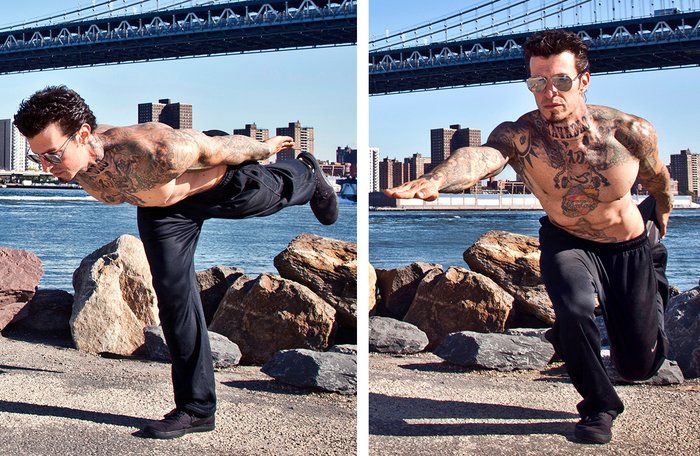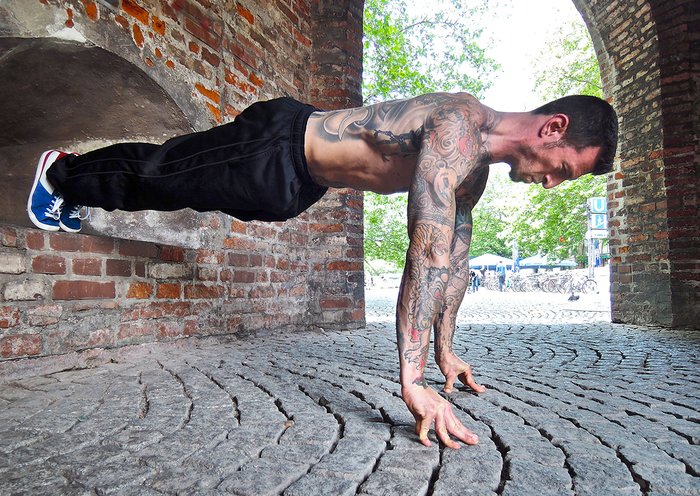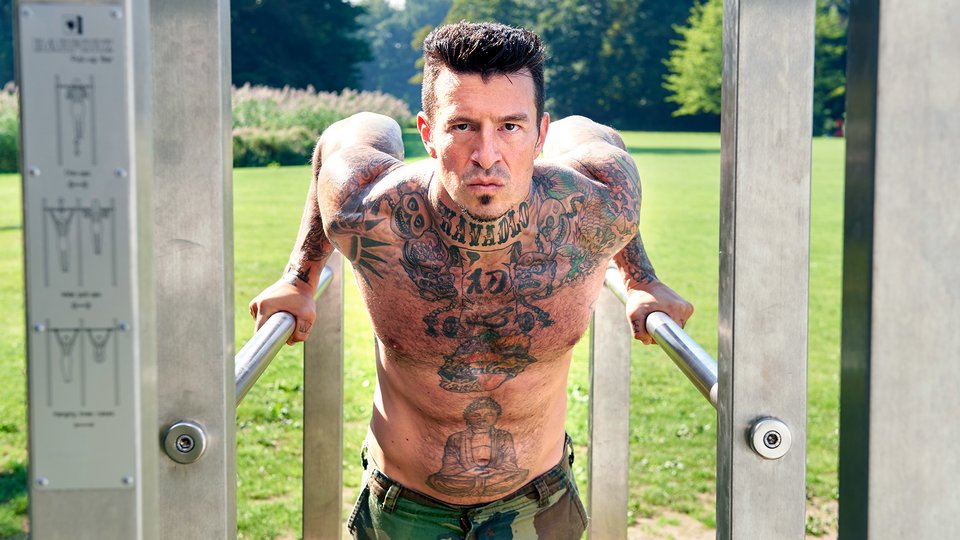Products You May Like
I remember the first time I heard the term “superset.” Even once I realized it was about training, the phrase evoked images of muscular heroes and diabolical villains—larger than life, majestic, and powerful. In a word, super!
Since I wanted to get strong, I decided at a young age to investigate this training methodology, and it has continued to pay off even on the far side of 40.
As you probably know, the term “superset” refers to the act of doing two different exercises in a row, with very little to no rest in between. There are many advantages to performing supersets. Here are just a few:
Advantage 1: Getting More Done in Less Time
When you incorporate supersets into your training, you can essentially allow yourself to recover from one exercise, while performing another.
Think about it: When supersetting different body parts (dips into pull-ups, for example), we can emphasize one muscle group (in this case chest and tris vs back and bis) while the other one rests. This is often referred to as “active recovery” and can help you get an efficient, effective workout on days when hours are limited.
Advantage 2: Maximizing a Single Muscle Group
Despite what I just said, there is no rule that says you have to do opposing muscle groups or upper-to-lower supersets to get a great workout! In fact, you can also use supersets for the same body part or muscle group to double down on your training.
Advantage 3: Peripheral Cardio Effect
When you work out, your blood flows to the area that’s being trained, hence the often-sought “pump.”
Consider this when you superset upper-body with lower-body training. Training push-ups will promote your blood to flow into the chest, shoulders, and arms. Following up directly with a leg exercise gets the blood flowing down to the lower extremities—and it’s gotta go through your heart to get there!
In my experience, upper/lower supersetting can be some of the best cardio and conditioning work out there.
Advantage 4: Diversify Your Training
There’s a lot of talk these days about “muscle confusion” and its alleged physical benefits. To be clear, I don’t agree with this notion. In my experience, it’s the basics that work; the most effective exercises are the ones that have stood the test of time.
But that doesn’t mean you can’t benefit from mixing it up sometimes! The reason I suggest mixing up your training by including supersets is to alleviate mental plateaus, not physical ones. Sometimes, when you do the same exercises in the same order on the same day, again and again, you may be tempted to phone it in, rather than giving all you’ve got. Not good for gains! Throwing in some supersets can help you avoid getting stagnant in your workouts.
Here are five of my favorite calisthenics supersets. Each one offers its own unique set of challenges. Get comfortable with each exercise on its own before incorporating it into a superset. Let’s do it!
Superset 1: Parallel-Grip Pull-up with Parallel-Grip Dip
The pull-up and the dip are two of the most foundational calisthenics exercises, and for good reason. Combining them into a push-pull pairing is also one of my personal favorite ways to blast the entire upper body.
Why it makes sense: This superset requires you to train two opposing upper-body muscle groups back to back. What makes it unique is the grip. By performing the pull-ups on parallel bars, you maintain the same “palms in” hand placement as the dips, protecting your shoulders from potential strain and also providing neurological consistency throughout the workout.

Trainer talk: Push-ups can also work here, but I prefer dips because they’re a more difficult upper-body exercise than push-ups, which are typically paired with pull-ups. This combo is a more balanced push-pull alternative in terms of exertion.
Superset 2: Single-Leg Squat with Single-Leg Deadlift
Detractors of bodyweight training often perpetuate the misconception that you can’t get strong legs without adding weight. As I’ve been writing on Bodybuilding.com for years, this isn’t so!
Like the previous combination, this superset also focuses on opposing muscle groups, but for the lower body.
Why it makes sense: The single-leg squat and “drinking bird”-style deadlift both train one side of the body at a time. This “unilateral training” is a fantastic way to expose muscular imbalances and maximize your focus on each individual side. The fact that these exercises are performed one leg at a time allows us to focus on our weaknesses.

Trainer talk: You can perform single-leg squats with your non-squatting leg either in front (pistol squat) or behind you (shrimp squat) for different emphasis. Both these exercises are a fusion of strength, mobility, and balance. Not only will you get stronger, you’ll also improve your flexibility and movement.
Superset 3: Jump Squat with Plyometric Push-up
The classic combination of squats and push-ups is a calisthenics staple. By incorporating plyometrics into this already taxing combo, we can get a great deal more out of this equipment-free sequence. I like to call this combo “The Heartbreaker.”
Why it makes sense: If you want to get the most bang for your proverbial buck without using any gear at all, this is a great way to go. Fast, explosive movements recruit all kinds of muscle, while also giving you a serious conditioning boost.
Trainer talk: The phrase “plyometrics” refers to an explosive exercise where the muscles explode quickly out of a stretch position, and the body (or part of it) gets airborne. Although there are many variations in existence, they all require pushing into the ground fast and hard in order to generate the requisite force needed. A key component for creating explosive force is to push into the ground fast and hard, almost as if trying to push through the floor. If you’re new to plyometrics, be mindful of the impact on your wrists and ankles.
Superset 4: Feet-Elevated Push-up with Hands-Elevated Push-up
Both these exercises target the same body parts, chest and triceps, but from different angles and with varying degrees of leverage. A warning: The pump is sneaky good!
Why it makes sense: This combination is almost like performing a dropset with weights or machines. Working hands-elevated push-ups right after feet-elevated push-ups will enable you to squeeze in some extra reps that you may not have thought possible, without sacrificing form.

Trainer talk: Placing your feet on a bench or other elevated surface puts more of your body weight into your hands. Placing your hands on the bench does the opposite. In progressive calisthenics, this is referred to as “weight-to-limb” ratio.
Superset 5: Superman with Dragon Flag
This superset, which I like to call “Hardcore on the Floor” consists of two of my favorite moves. Sadly, both of them are sometimes (inappropriately) categorized as simply “abs” or “back” exercises. To be clear, yes, they do emphasize the core, but they also challenge much more, including your arms, legs, chest, and shoulders. These exercises can both be trained for reps or as isometric holds.
Why it makes sense: It’s important to train the undivided anterior and posterior chains of the body for complete strength and fitness. Remember, there’s more to a split than upper and lower!
Trainer talk: You will find that a level of full-body tension will be necessary for clean execution. Ultimately, aim to keep your elbows and knees locked for both these exercises, although you may need to bend slightly at one or both knees at the beginning. Take your time and be patient.
With the right programming, bodyweight training can achieve unbelievable results. Let Andy Speer show you how in Phase 1 of Total Fitness, an innovative eight-week program to build a total athlete from the ground up! Only in Bodybuilding.com BodyFit Elite.
